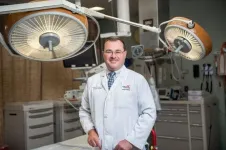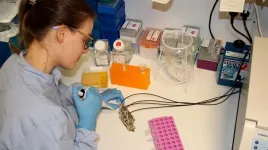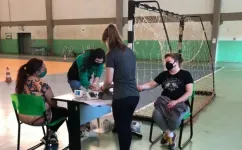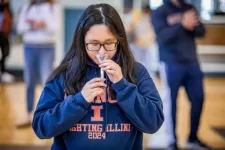Repairing 'broken' hearts -- new promising surgical technique for heart attacks
Medical researchers devise a new way to repair the ruptured wall of the heart from a severe heart attack
2021-06-30
(Press-News.org) Heart attack, medically known as myocardial infarction (MI), is a common heart condition. MI is caused by problems in blood supply to parts of the heart. In severe cases, MI could be accompanied by ruptures in the wall separating different parts of the heart, such as in the ventricular septum (a wall that separates the right ventricle that pumps deoxygenated blood to the lungs for oxygenation, from the left ventricle that pumps oxygenated blood to rest of the body). Not surprisingly, without appropriate surgical intervention, a VSR due to MI increases the chances of death.
Current surgical techniques used to close VSR due to MI have proven ineffective in several situations, which put a group of Chinese medical researchers to work. These researchers from The First Affiliated Hospital of Zhengzhou University and Capital Medical University in China specifically worked on VSR due to MI accompanied by life-threatening fluctuations in blood pressure, or hemodynamic instability (HI). The researchers successfully devised a surgical technique that improved outcomes in patients suffering from VSR and HI due to MI (VSR-HI-MI), according to a study published in Chinese Medical Journal. Further explaining the motivation of their study, Dr. Chao Liu (first author of the study) says, "We aimed to present a novel surgical repair technique that can be safely, feasibly, and effectively used in hemodynamically unstable patients with VSR in the acute phase."
The medical researchers, who aimed to save the lives of patients with VSR-HI-MI, call their novel surgical technique as SurCOP, a method combining devices called an occluder and a patch. While the occluder is used to repair the "hole" in the heart, the patch (derived from biocompatible materials) is used to close it. This is an upgraded version of the conventionally used surgical method in which only a simple patch is used. The doctors then tested the improved technique on nine consenting patients with VSR-HI-MI and compared the outcomes to 54 others. The results showed that the procedure had an impressive 100% success rate. Also, compared to a bleak 10% survival rate if managed conservatively, SurCOP achieved a promising 77.8% survival rate when a median follow-up time of 187 days were considered. Importantly, none of the patients who underwent SurCOP developed VSR after the surgery.
These are incredibly promising findings. Overall, the study highlights how well the surgical technique of SurCOP, tackles the clinical problems posed by VSR-HI-MI. Elated at the success of the study, Dr. Liu concludes, "Our experience has shown that the SurCOP technique is a safe, easy-to-manipulate, and effective method. We hope that we could receive feedback from surgeons who will attempt performing this alternative therapeutic technique and work together to improve the prognosis of patients with VSR."
Indeed, the world can now heal a little better from complications arising from heart attacks.
INFORMATION:
Reference
Title of original paper: A new surgical technique for post-myocardial infarction ventricular septal rupture with hemodynamic instability
Journal: Chinese Medical Journal
DOI: https://doi.org/10.1097/CM9.0000000000001442
ELSE PRESS RELEASES FROM THIS DATE:
2021-06-30
Bioplastics -- biodegradable plastics made from biological substances rather than petroleum -- can be created in a more economical and environmentally friendly way from the byproducts of corn stubble, grasses and mesquite agricultural production, according to a new study by a Texas A&M AgriLife Research scientist.
green tractor pulling a red cart through a field of bioenergy sorghum that is taller than the tractor
A bioenergy sorghum crop is harvested near College Station. (Texas A&M AgriLife photo)
This new approach involves a "plug-in" preconditioning process, a simple adjustment for biofuel refineries, said Joshua Yuan, Ph.D., AgriLife Research scientist, ...
2021-06-30
Dinosaurs roamed the Earth more than 65 million years ago, and paleontologists and amateur fossil hunters are still unearthing traces of them today. The minerals in fossilized eggs and shell fragments provide snapshots into these creatures' early lives, as well as their fossilization processes. Now, researchers reporting in ACS Earth and Space Chemistry have analyzed the molecular makeup of fossilized dinosaur eggshells from Mexico, finding nine amino acids and evidence of ancient protein structures.
Current research indicates that all dinosaurs laid eggs, though most haven't survived the test of time. And because whole eggs and shell fragments are very rare fossils, their mineral composition ...
2021-06-30
Newly published research shows that a screening program in the University of Cincinnati Medical Center Emergency Department helped detect an outbreak of HIV among persons who inject drugs in Hamilton County, Ohio, from 2014-18.
The study was published in PLOS ONE.
The results of the study highlight UC contributions to public health surveillance as yet another reason why emergency departments should be screening for undiagnosed HIV infections, according to Michael Lyons, MD, associate professor in the Department of Emergency Medicine at the UC College of ...
2021-06-30
Some people casually smoke cigarettes for a while and then stop without a problem, while others develop long-term, several packs-per-day habits. A complex mix of environmental, behavioral and genetic factors appear to raise this risk for nicotine dependence.
Studies of groups of twins suggest that 40 to 70 percent of the risk factors are heritable. Until recently, however, studies have only explained about 1 percent of the observed variation in liability to nicotine dependence, using a genetic score based on how many cigarettes a person smokes per day.
A new study led by psychologists ...
2021-06-30
Using an experimental model to simulate the blood-brain barrier, scientists in Sweden reported in unprecedented detail how antioxidants protect the brain from inflammation caused by neurodegenerative diseases such as Alzheimer's and Parkinson's.
The study, conducted as a proof of concept by brain model developers at KTH Royal Institute of Technology in Stockholm, showed in minute-by-minute detail how the blood-brain barrier reacts to high levels of inflammation after the administration of a next-generation derivative of the widely-used anti-inflammatory drug, NAC (N-acetylcysteine).
The testing of NACA (N-Acetylcysteine Amide) for the first time with ...
2021-06-30
A new way to target a mutant protein which can cause the deadliest of cancers in humans has been uncovered by scientists at the University of Leeds.
The mutated form of the RAS protein has been referred to as the "Death Star" because of its ability to resist treatments and is found in 96% of pancreatic cancers and 54% of colorectal cancers.
RAS is a protein important for health but in its mutated form it can be switched on for longer, leading to the growth of tumours.
One drug has already been approved for treatment but it can only tackle a small subset of ...
2021-06-30
In a study involving 34 women aged 50-70, researchers at the University of São Paulo (USP) in Brazil performed objective measurements of the impact on the subjects' health of the decrease in physical activity observed during the period of social distancing and isolation imposed by COVID-19. Tests conducted after the first 16 weeks of confinement pointed to a deterioration in their overall health, including loss of muscle strength and diminished aerobic capacity, as well as elevated levels of cholesterol and glycated hemoglobin, both of which are risk factors for metabolic disorders.
The study was supported by São Paulo Research Foundation ...
2021-06-30
When it comes to understanding and predicting trends in energy use, the internet is a tough nut to crack. So say energy researchers Eric Masanet, of UC Santa Barbara, and Jonathan Koomey, of Koomey Analytics. The two just published a peer-reviewed commentary in the journal Joule discussing the pitfalls that plague estimates of the internet's energy and carbon impacts.
The paper describes how these errors can lead well-intentioned studies to predict massive energy growth in the information technology (IT) sector, which often doesn't materialize. "We're not saying the energy use of the internet isn't a ...
2021-06-30
CHAMPAIGN, Ill. -- The chance of detecting the virus that causes COVID-19 increases with more frequent testing, no matter the type of test, a new study found. Both polymerase chain reaction and antigen tests, paired with rapid results reporting, can achieve 98% sensitivity if deployed at least every three days.
"This study shows that frequent testing can be really effective at catching COVID-19 infections and potentially blocking transmission," said study leader Christopher Brooke, a virologist and professor of microbiology at the University of Illinois Urbana-Champaign. "There are many places where vaccination is not yet widespread. With the rise of variants, testing remains an important tool ...
2021-06-30
QUT researchers have developed a new machine learning mathematical system that helps to identify and detect changes in biodiversity, including land clearing, when satellite imagery is obstructed by clouds.
Using statistical methods to quantify uncertainty, the research, published in Remote Sensing in Ecology and Conservation, analysed available satellite images of an 180km square area in central south-east Queensland.
The region is home to many native species including the critically endangered northern hairy-nosed wombat and the vulnerable greater glider, and the ...
LAST 30 PRESS RELEASES:
[Press-News.org] Repairing 'broken' hearts -- new promising surgical technique for heart attacks
Medical researchers devise a new way to repair the ruptured wall of the heart from a severe heart attack




